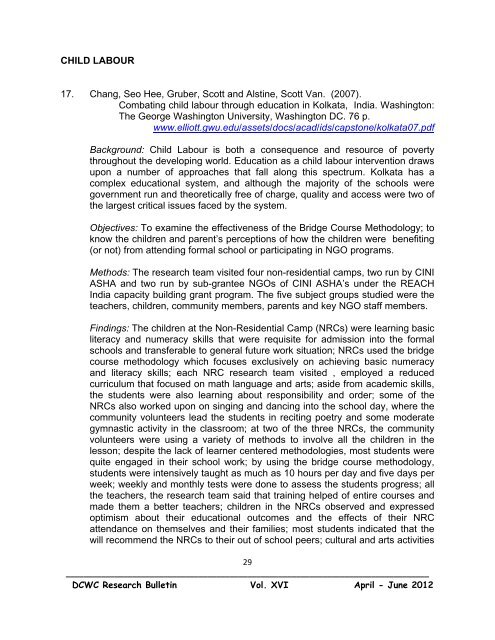Vol. XVI Issue 2 April - June 2012 2012 Documentation ... - Nipccd
Vol. XVI Issue 2 April - June 2012 2012 Documentation ... - Nipccd
Vol. XVI Issue 2 April - June 2012 2012 Documentation ... - Nipccd
Create successful ePaper yourself
Turn your PDF publications into a flip-book with our unique Google optimized e-Paper software.
CHILD LABOUR<br />
17. Chang, Seo Hee, Gruber, Scott and Alstine, Scott Van. (2007).<br />
Combating child labour through education in Kolkata, India. Washington:<br />
The George Washington University, Washington DC. 76 p.<br />
www.elliott.gwu.edu/assets/docs/acad/ids/capstone/kolkata07.pdf<br />
Background: Child Labour is both a consequence and resource of poverty<br />
throughout the developing world. Education as a child labour intervention draws<br />
upon a number of approaches that fall along this spectrum. Kolkata has a<br />
complex educational system, and although the majority of the schools were<br />
government run and theoretically free of charge, quality and access were two of<br />
the largest critical issues faced by the system.<br />
Objectives: To examine the effectiveness of the Bridge Course Methodology; to<br />
know the children and parent’s perceptions of how the children were benefiting<br />
(or not) from attending formal school or participating in NGO programs.<br />
Methods: The research team visited four non-residential camps, two run by CINI<br />
ASHA and two run by sub-grantee NGOs of CINI ASHA’s under the REACH<br />
India capacity building grant program. The five subject groups studied were the<br />
teachers, children, community members, parents and key NGO staff members.<br />
Findings: The children at the Non-Residential Camp (NRCs) were learning basic<br />
literacy and numeracy skills that were requisite for admission into the formal<br />
schools and transferable to general future work situation; NRCs used the bridge<br />
course methodology which focuses exclusively on achieving basic numeracy<br />
and literacy skills; each NRC research team visited , employed a reduced<br />
curriculum that focused on math language and arts; aside from academic skills,<br />
the students were also learning about responsibility and order; some of the<br />
NRCs also worked upon on singing and dancing into the school day, where the<br />
community volunteers lead the students in reciting poetry and some moderate<br />
gymnastic activity in the classroom; at two of the three NRCs, the community<br />
volunteers were using a variety of methods to involve all the children in the<br />
lesson; despite the lack of learner centered methodologies, most students were<br />
quite engaged in their school work; by using the bridge course methodology,<br />
students were intensively taught as much as 10 hours per day and five days per<br />
week; weekly and monthly tests were done to assess the students progress; all<br />
the teachers, the research team said that training helped of entire courses and<br />
made them a better teachers; children in the NRCs observed and expressed<br />
optimism about their educational outcomes and the effects of their NRC<br />
attendance on themselves and their families; most students indicated that the<br />
will recommend the NRCs to their out of school peers; cultural and arts activities<br />
29<br />
__________________________________________________________________________________<br />
DCWC Research Bulletin <strong>Vol</strong>. <strong>XVI</strong> <strong>April</strong> - <strong>June</strong> <strong>2012</strong>

















